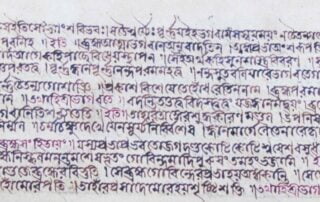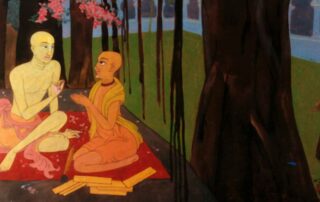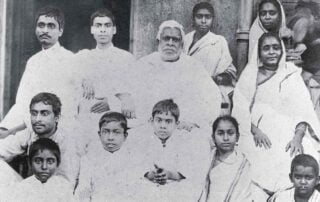Vaiṣṇava Siddhānta Mālā 1.4
‘Vaiṣṇava Siddhānta Māla,’ written by Bhaktivinda Ṭhākura in 1888, was a work meant to introduce the general public to the nine basic principles of Gauḍīya Vaiṣṇava philosophy. The first part of the book is in the form of questions and answers. Subsequent chapters deal with the topic of the Holy Name.
Vaiṣṇava Siddhānta Mālā 1.3
‘Vaiṣṇava Siddhānta Māla,’ written by Bhaktivinda Ṭhākura in 1888, was a work meant to introduce the general public to the nine basic principles of Gauḍīya Vaiṣṇava philosophy. The first part of the book is in the form of questions and answers. Subsequent chapters deal with the topic of the Holy Name.
Vaiṣṇava Siddhānta Mālā 1.2
‘Vaiṣṇava Siddhānta Māla,’ written by Bhaktivinda Ṭhākura in 1888, was a work meant to introduce the general public to the nine basic principles of Gauḍīya Vaiṣṇava philosophy. The first part of the book is in the form of questions and answers. Subsequent chapters deal with the topic of the Holy Name.
Vaiṣṇava Siddhānta Mālā 1.1
‘Vaiṣṇava Siddhānta Māla,’ written by Bhaktivinda Ṭhākura in 1888, was a work meant to introduce the general public to the nine basic principles of Gauḍīya Vaiṣṇava philosophy. The first part of the book is in the form of questions and answers. Subsequent chapters deal with the topic of the Holy Name.
Hari-nāma Cintāmaṇi – Chapter 3
Śrī Hari-nāma Cintāmaṇi was written in 1900 by Śrīla Bhaktivinoda Ṭhākura. This work of fifteen chapters composed in Bengali verse form, explains in detail the process of chanting the Holy Name, and especially deals with the ten offences as delineated in the Padma Purāṇa. The narrative is a dialogue betweem Śri Caitanya Mahāprabhu and Śrīla Hari Dāsa Ṭhākura. In the introduction, Bhaktivinoda Ṭhākura states that Hari-nāma Cintāmaṇi is based upon rare texts that he discovered during his research.
Īśopaniṣad
With the Vedārka Dīdhiti commentary Your Content Goes Here (translated by Swami B.V. Giri) oṁ pūrṇam adaḥ pūrṇam idaṁ pūrṇāt pūrṇam udacyate pūrṇasya pūrṇam ādāya pūrṇam evāvaśiṣyate TEXT 1 īśāvāsyam idam sarvaṁ yat kiñca jagatyāṁ jagat tena tyaktena bhuñjīthā mā gṛdhaḥ kasya svid dhanam Vedārka Dīdhiti Commentary jagatyāṁ viśve yata kiñca yat kiñcit, viśve yat kiñcid-asti tat sarvaṁ īśāvasyaṁ īśane āvṛtam. tena hetunā tyaktena tyāgena jagata bhuñjīthāḥ bhogaṁ kurvīthāḥ. kasya siddhanaṁ kasya-chiddhanaṁ mā gṛdhaḥ na ākaṅkṣīḥ. (“Everything in this world is covered by Īśvara. Therefore, one should practice tyāga [renunciation] along with bhoga [enjoyment]. One Read More...
Hari-nāma Cintāmaṇi – Chapter 2
Śrī Hari-nāma Cintāmaṇi was written in 1900 by Śrīla Bhaktivinoda Ṭhākura. This work of fifteen chapters composed in Bengali verse form, explains in detail the process of chanting the Holy Name, and especially deals with the ten offences as delineated in the Padma Purāṇa. The narrative is a dialogue between Śri Caitanya Mahāprabhu and Śrīla Hari Dāsa Ṭhākura. In the introduction, Bhaktivinoda Ṭhākura states that Hari-nāma Cintāmaṇi is based upon rare texts that he discovered during his research.
Datta Vaṁśa Mālā – Part 2
‘Datta Vaṁśa Mālā’ was written by Bhaktivinoda Ṭhākura in 1876, and is a genealogical description of his dynasty, the Dattas. The first part is a series of 32 Sanskrit verses, to which the Ṭhākura gave an expanded Bengali translation/commentary to. The second part of the book is a lengthy genealogy of the Datta dynasty that Bhaktivinoda had collected from various family sources.
Datta Vaṁśa Mālā – Part 1
‘Datta Vaṁśa Mālā’ was written by Bhaktivinoda Ṭhākura in 1876, and is a genealogical description of his dynasty, the Dattas. The first part is a series of 32 Sanskrit verses, to which the Ṭhākura gave an expanded Bengali translation/commentary to. The second part of the book is a lengthy genealogy of the Datta dynasty that Bhaktivinoda had collected from various family sources.
Datta Vaṁśa Mālā – Preface
‘Datta Vaṁśa Mālā’ was written by Bhaktivinoda Ṭhākura in 1876, and is a genealogical description of his dynasty, the Dattas. The first part is a series of 32 Sanskrit verses, to which the Ṭhākura gave an expanded Bengali translation/commentary to. The second part of the book is a lengthy genealogy of the Datta dynasty that Bhaktivinoda had collected from various family sources.












